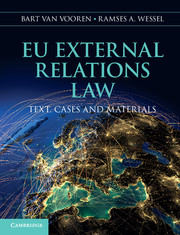Book contents
- Frontmatter
- Contents
- Table of cases
- Table of instruments and legislation
- Preface
- Acknowledgements
- List of abbreviations
- 1 The EU as a global legal actor
- 2 Instruments of EU external action
- 3 Existence of EU external competence
- 4 Nature of EU external competence
- 5 Scope and choice of EU external competence
- 6 The duty of cooperation
- 7 EU law and international law
- 8 The EU and international institutions
- 9 Common Commercial Policy
- 10 EU development policy
- 11 Common Foreign and Security Policy
- 12 Common Security and Defence Policy
- 13 The external dimension of the internal energy market
- 14 The external dimension of freedom, security and justice
- 15 The EU and its neighbours
- Index
- References
12 - Common Security and Defence Policy
- Frontmatter
- Contents
- Table of cases
- Table of instruments and legislation
- Preface
- Acknowledgements
- List of abbreviations
- 1 The EU as a global legal actor
- 2 Instruments of EU external action
- 3 Existence of EU external competence
- 4 Nature of EU external competence
- 5 Scope and choice of EU external competence
- 6 The duty of cooperation
- 7 EU law and international law
- 8 The EU and international institutions
- 9 Common Commercial Policy
- 10 EU development policy
- 11 Common Foreign and Security Policy
- 12 Common Security and Defence Policy
- 13 The external dimension of the internal energy market
- 14 The external dimension of freedom, security and justice
- 15 The EU and its neighbours
- Index
- References
Summary
Central issues
For almost fifty years, security and defence cooperation was excluded from the EU and in fact enjoyed ‘taboo status’. Member States were hesitant to hand over powers in this sensitive area to the ‘supranational’ EC and many preferred to give priority to cooperation in NATO. Yet, since the beginning of the third millennium, CSDP has developed into a fully fledged policy, as part of the CFSP (see Chapter 11), but increasingly as a stand-alone policy field with its own rules, procedures and bodies.
This chapter will address decision-making in CSDP as well as the role of the institutions and the available legal instruments. We will also go back in time to trace the origins of CSDP, in order to explain its current nature. Over twenty-five missions have been established since the creation of CSDP, and in this chapter we will look at the different types of missions as well as at their (international) legal ramifications.
Introduction
In the previous chapter we referred to the origins of the Union’s foreign, security and defence policy. As we have seen, during the 1950s and 1960s far-reaching proposals were tabled to establish a common defence policy with supranational features. These proposals were never accepted, and a security and defence policy developed partly as part of the CFSP and partly autonomously. Over the last decade, the EU has launched over twenty-five civilian missions and military operations on three continents deployed in response to crises, ranging from post-tsunami peace-building in Aceh, to protecting refugees in Chad, to fighting against piracy in and around Somalian waters. The CSDP has developed into a major policy area in EU external relations. Like CFSP, it is formed on the basis of specific rules and procedures, but at the same time we have witnessed a development from a largely intergovernmental policy area to a ‘Brussels-based’ cooperation in which EU preparatory organs play a leading role.
- Type
- Chapter
- Information
- EU External Relations LawText, Cases and Materials, pp. 400 - 437Publisher: Cambridge University PressPrint publication year: 2014



